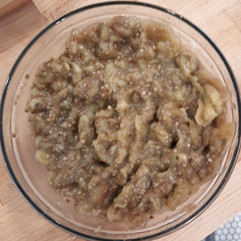Caponata Ragu
- Tracy Scheckel
- Jul 25
- 4 min read

One way I love eggplant is in caponata. In my family, it was served chilled around the holidays, came out of a Progresso can, and, from what I remember, was rather on the expensive side. We would spoon the yummy-ness onto sliced baguettes and enjoy with the other antipasto delicacies.
The name originates from Sicilian dialect Italian capunata, or sailor's dish of biscuit steeped in oil and vinegar, with chopped vegetables. Caponata typically consists of eggplant, onions, tomatoes, olives, capers, vinegar, sugar, and sometimes anchovies, basil, pine nuts, or some combination thereof. It ALWAYS has eggplant.
One rainy cool summer Sunday, I got to thinking about how I might modify caponata to serve as a pasta sauce (no meat, so it's sauce). I did some recipe searching and came across a meatless Bolognese recipe that used eggplant to provide the texture that meat would otherwise provide. What I had in mind was something that was full bodied but with obvious chunks of the eggplant, onions, tomatoes etc. The Bolognese recipe instructed you to oven roast a whole eggplant and then scrape and mash the pulp and use that to replace the meat.
That inspired me, and since I had 2 eggplants in the house, I roasted the larger one for the 'meat' and reserved the smaller for the chunks I was looking for. What I ultimately devised is a combination of Bolognese and Caponata, and it satisfied us well when I served it on Sunday pasta!
Where the Caponata is concerned, I will share my recipe in the coming weeks, but for now, I'll share that it's evolved from what came in that Progresso can when I was a kid. I use eggplant, tomatoes, onions, capers, green olives, mushrooms, celery, garlic, red wine, and balsamic vinegar. My Bolognese, which I will also share soon has a combination of meats, carrots, celery, onion, garlic, mushrooms, red peppers, tomatoes, red wine, and cream.
What I did for this dish was to start like I was making my traditional meat filled Bolognese, but substitute the roasted eggplant when it was time to add the meat. Then once the sauce had boiled for a couple of hours, I added those larger chunks that I mentioned.

Since I'd never roasted an eggplant whole before, I did some research on that to find out that the perfect internal temp for a whole roasted eggplant is 183.5 degrees. That's when the pectin breaks down to give you just the right texture. I roasted it until it reached 184 degrees since I can't set my digital thermometer to a half of a degree. It was really the prefect texture to incorporate into this recipe.
THE RECIPE:
For the Sauce:
1 large eggplant roasted to 184 degrees
1/2 C olive oil
1/2 C minced sweet onion
3 large cloves of garlic minced
1/2 C minced carrot
1/2 C minced celery
1/2 C minced mushroom stems (I save the whole mushrooms for the chunky part)
1/2 C minced sweet red pepper
1 - 12oz can tomato paste
1 - 28oz can of tomato puree
2 cans of diced tomatoes
1C dry red wine
1/4 C herbs de Provence
Salt / Pepper and crushed red pepper to taste
Heat the oil in a stock pot and add the onion and garlic to simmer until aromatic.
Add remaining minced vegetables and simmer covered until they are almost completely dissolved.
While the vegetables are cooking, scrape out the eggplant and mash or food process the pulp (meat). Note the texture below. You don't want to completely puree the eggplant, but you do want to avoid any stringiness.
Cone the minced vegetables are cooked down, add the tomato paste and let it cook until darkened -- almost burned but not.
Use the red wine to wash any paste residue from the can and add to the sauce
Once the wine is well combined, add the mashed eggplant and stir to combine.
Once the sauce is uniform in color and consistency, add the puree and the canned diced tomatoes. (Note that you can use pureed roasted plum tomatoes in place of the puree and fresh chopped compari or ripe plums in place of the canned diced tomatoes, but I used what I had on hand for this batch.)
Add the herbs de Provence, salt and peppers, cover and simmer on very low stirring occasionally for a couple of hours.
For the Chunks
1/2 C carrot cut into 1/4 to 1/2" chunks
1/2 C onion in 1/2" chunks
1 - 2 C mushrooms cut into chunks
1-2 C eggplant skin on and cut into chunks (Note: the eggplant I had was kind of large and since I like the skin on each chunk to help stabilize it in the sauce, I shaved the inside and diced it and tossed it in with the cooking sauce -- leaving 1/2" chunks with the skin on them for my chunky element.)
1/4 to 1/2 C capers
1/4 to 1/2 C balsamic vinegar to taste
Lots of parmesan grated and shredded for tossing and grated for serving
After the base sauce has cooked for a couple of hours, add the chinks and simmer for 30 to 45 minutes until the chunks are tender
Add the capers and balsamic and stir to combine.
Remove from heat and it's ready to serve or can be reheated when you're ready to serve over ziti, rigatoni or some other pasta with body.
To Serve:
Toss sauce with pasta
Add a cup of shredded parmesan half at a time.
Stir in the first half and use the second to garnish.

This marriage of Bolognese and caponata turned out to be a prefect hearty vegetarian alternative to a meaty Bolognese.









































